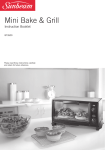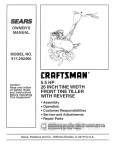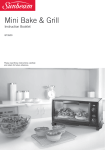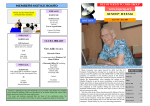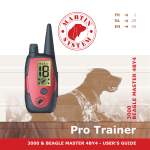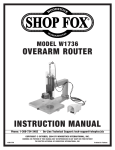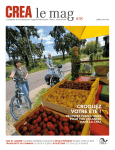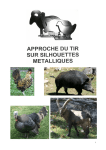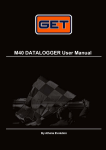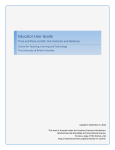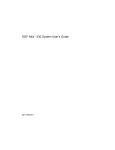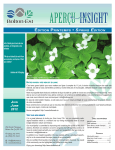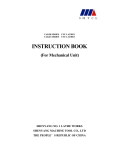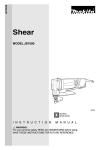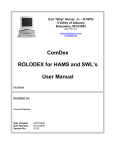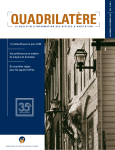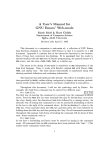Download Pelt Handling For Profit - Fur Harvesters Auction Inc.
Transcript
PELT HANDLING Fo r P r o f i t Proper Pelt Handling Begins with the Proper Equipment www.furharvesters.com Official Publication of Fur Harvesters Auction Inc. To Our Fellow Fur Harvesters Pelt Handling for Profit has been created as a quick and easy reference for those trappers who want to maximize the value of their fur harvest. The tips included are based on information obtained from some of our best pelt handlers, with additional input from our team of experienced fur graders. The combined effort allows any trapper to properly prepare fur the way the international market wants it, leading to increased returns on your hard-earned catch. need, from certified traps to knives to boards to fleshing beams and more. Catalogs are available from Trans Canada Trapline Company, 1867 Bond St., North Bay, ON P1B 8K6, phone (705) 495-3511, fax (705) 4954939, e-mail [email protected], or by clicking on the Trap Store tab on www.furharvesters.com. We hope this quick and easy reference manual will assist you in obtaining the maximum value from your fur harvest. A combination of hands-on experience and having the right tools will make the job of pelt preparation easier, Good luck on the trapline! faster and more rewarding. Our trap department stocks just about every fur handling tool that you are likely to The FHA Team General Shipping Information Over 11,000 trappers market their pelts through Fur Harvesters Auction Inc. annually. Our extensive agent network throughout Canada and the United States allows trappers to easily and economically ship their pelts to North Bay, Ontario. Your agent will obtain all the necessary permits and documentation required to ship your fur. While your fur is at our agent’s premises or is on route to North Bay, your fur is insured against fire and theft. 4. If you have more than one bag, only state the number of skins which are in each bag. Write your total number of parcels ( 1 of 5 etc.) on the information side of tag. 5. Beavers should be placed in bag flat, fur to fur, leather to leather. Never roll your beaver pelts. 6. Provinces or states have specific laws regarding furbearers. Please check with your local FHA agent or your DNR/MNR officials regarding rules that may affect you. Shipping Instructions 1. All fur must be stretched and dried. Castoreum must also be dried and shipped in either paper bag or Special Instructions for US Shippers cardboard box. Never ship castoreum in plastic bags or 1. Due to US Fish and Wildlife rules, trappers cannot plastic containers. ship direct and therefore must ship through one of our receiving agents. 2. Shipping bags and identification tags are provided free of charge to FHA shippers. Please contact your 2. CITES Articles (Otter, Bobcat, Lynx): All pelts must local agent. be correctly tagged with the CITES tag through the pelt and properly sealed. 3. Parcel Identification: FHA provides a 2 part shipping tag. Attach the large portion to the outside of your 3. Please inform your agent of all CITES pelts when parcel and insert the small portion of tag inside the bag. shipping. Package CITES pelts separately from your It’s important that both tags are filled out correctly with Non-CITES pelts. your name, complete mailing address, phone number, and trapping license number. This information is used 4. There is a $2.00 per pelt handling charge for CITES to process your fur cheque. On the reverse side state the pelts. species and quantities that are in the bag. This manual was written by trappers for Table of Contents the benefit of trappers. We encourage General Shipping Information trappers to photocopy this manual and Introduction 2 General Fur Handling Tips 3 Grading Terminology 4 Beaver 5 Beaver Castoreum 7 North Bay, ON P1B 8K6 Beaver Tails 8 Tel (705) 495-4688 Beaver Table 8 Fax (705) 495-3099 Marten 9 E-mail: [email protected] Red Fox 10 Fisher 12 Lynx & Bobcat 13 Coyote 14 Grey Fox 15 Otter 16 Mink 17 Raccoon 18 Muskrat 19 Squirrel & Weasel 20 Opossum & Skunk 21 Wolf & Wolverine 22 FHA’s Receiving Agents 24 pass it on to fellow trappers. Additional copies can be obtained by contacting: Fur Harvesters Auction Inc. 1867 Bond Street, Box 1455 www.furharvesters.com Production & Design: Luc Graveline Published June 2014 Cover Photo Walker Black from Sebright, ON skinning a muskrat at FHA’s Annual Trappers Convention How to Prepare Pelts for Taxidermy Inside Cover Inside Back Cover Canada’s Premier Supplier of Furbearer Management and Marketing Equipment www.furharvesters.com Introduction - Attending Fur Harvester’s Convention is a great way to get tips. Each year thousands of dollars are lost due to improperly handled fur. This manual has been developed by trappers and fur graders to assist trappers in achieving the best price possible for their fur by eliminating handling errors. There is a saying here at Fur Harvesters Auction that states: You can’t turn a $10.00 pelt into a $100.00 pelt, but you can easily turn a $100.00 pelt into a $10.00 pelt. Hopefully by reading this manual, even the most experienced fur handler can pick up a hint or two to help them realize the maximum price for their furs. Equipment and trap placement To begin proper fur handling, the trapper must use the proper equipment for the job. The proper size trap or snare for the targeted species is a must. A trap of inadequate power or quality will result in a poorly dispatched animal. This could lead to rubbed fur, cut pelts and reduced value. Traps should be dyed or dipped and checked to ensure they are performing properly. Rusty traps are not nearly as effective as dyed or dipped traps. Also, rust stains on pelts depending on their severity may cause them to be downgraded. Next the trapper must look at where they set their traps. Make sure that when an animal is caught the fur will not become damaged by surrounding conditions. Set traps in such a manner that trapped animals will not come into contact with burrs, pine/spruce gum, excessive mud/dirt, become frozen to rocks, sticks, into ice, or be susceptible to mice who will chew off fur for nest linings. Using common sense and a little time in choosing trap placement can eliminate some fur damage even before the animal is skinned. Removing animals from the trap Special care must be taken when removing animals from traps and snares. If not careful, fur can be torn out which will damage the pelt. If an animal becomes frozen to the trap, take trap and all home to thaw out the animal. If an aquatic animal is partially frozen to the trap sometimes swishing the animal and trap in the water will loosen it from the trap. Do not try to force a snare off an animal’s neck. Wait until the animal is flexible enough that the snare can easily be removed or cut from the animal. Field care of animals After the animal is removed from the trap make sure it is clean. If it is full of mud, wash it in water or hose it off. If there is ice or snow on the animal do not remove it from trap, allow it to melt off in a warm place. If the weather is below freezing place animals in a sack of some sort to keep them from freezing to the bed of your truck, to the rack of a four-wheeler or snowmobile. If carrying an animal without a pack sack, try to avoid walking it through burrs. Remove excess water by shaking the animal by the head or by squeezing it out with your hands. This will speed up the drying process which would allow the animal to be skinned sooner. Checking traps regularly during mild weather is another aspect of good fur handling. Some animals such as muskrats, marten and fox will go bad quickly in warm weather. Depending on your local trap checking laws traps should be checked every other day during mild fall days or where a trapped animal will be subject to direct sunlight. Checking often also eliminates the chance of the trapped animal being eaten by another animal or bird. 2 Marketing of Pelts Beaver: Open skinned, oval pattern. Mink: Cased and fur in. It is recommended that saddle be left on but remove all grease from under the saddle. Otter: Cased and fur in. Raccoon: Cased and fur in. Skunk: Cased and fur in. Opossum: Cased and fur in. Muskrat: Cased and fur in, do not overscrape, remove all surface grease but leave saddle on. Squirrel & Weasel: Cased and fur in. Marten: Cased and fur out. Fisher: Cased and fur out. Lynx: Cased and fur out. Bobcat: Cased and fur out. Fox: Cased and fur out. Badger: Cased and fur in. Coyote: Cased and fur out. Timber Wolf: Cased and fur out, claw attached, ear cartilage out, lower lip on. Bear: Open skinned, claws and head and pads attached, ear cartilage out. Wolverine: Cased and fur out, claws attached, lower lip on. Seals: Open skinned, oval pattern TIP: Pelt your animals as quickly as possible. General Fur Handling Tips PELT SIZES While it is never wise to over-stretch fur, there are times when pelts will be on the borderline between two sizes when they are placed on the board. Pelts shrink slightly in length during drying, so it may be to the trapper’s advantage to stretch these borderline pelts just a little more to bring them up to the next largest size. To facilitate this, having the pelt sizes marked on our boards for each species may be helpful. FUR HANDLING AND MARKETING Proper fur handling and orderly marketing mean more dollars in trappers’ pockets. Specific pelting procedures for each furbearer are covered in the section pertaining to those furbearers, but there are important points that are common to all furbearers. Proper fur handling commences with setting the proper traps for each species to ensure clean captures and minimal damage. TRANSPORTING Furbearers should be transported in clean burlap or nylon bags (eg. feed sack) to ensure that they remain clean and that blood or dirt from one animal is not transferred to another. Never place wet furbearers directly onto metal racks of ATV’s or snowmobiles or the box of a pick-up truck in freezing weather. They will become solidly frozen and difficult to remove without doing major damage to the fur. CLEANING / STORAGE In general, furbearers should be dry before pelting. Before pelting, furbearers should be brushed lightly with a proper fur comb to remove burrs, mats and dirt, which may stain the fur, and cause cuts in the pelting process. If the fur is badly soiled, it should be washed lightly with clean water and allowed to dry before pelting commences. If you cannot skin the animal shortly after harvesting or if you choose to rough skin pelts and flesh at a later date, they should be frozen to preserve quality. Place furbearers or pelts in plastic bags and remove as much air as possible. Tie tightly and place in a freezer. Pelts that are to be frozen should be rolled nose to tail, leather in. Thaw slowly to prevent hair slip before pelting or fleshing. After fleshing and drying, pelts should be shipped to market as soon as possible. If you must store pelts for long periods they should be placed in a freezer. For short periods of storage, keep in a dark, cool dry room. Pelts may be wrapped lightly in newsprint, stored in burlap or nylon bags or hung from hooks or rafters. Ship to market in clean bags or cardboard boxes, never in plastic bags. Fur Combs The proper use of fur combs will increase the value of your fur. Pictured here are a number of different combs and brushes available to fur harvesters. On the right is a stone fur comb in the coarse model; next is a regular pet brush, followed by a slicker dog brush. Furs should be combed at least 3 times: once before skinning, once more before you put the pelt on the stretcher and finally before you ship your fur to auction. Dog Brush Slicker Brush Course Stone Fur Comb Sawdust To help clean wet fur, a good tip is to have dry clean sawdust on hand. Sawdust will help clean the fur of any dirt and grease. Use the sawdust by covering the pelt and then comb the pelt out. The sawdust will soak up the extra moisture and dirt. If using sawdust during the fleshing process, make sure the excess is removed prior to drying your pelt. Fans The use of a fan will help dry furs that are soaked and will also help dry the pelt once placed on a stretcher. It is safer to use a fan to help dry a pelt on the board than to use excessive heat. Using too much heat will cause the pelt to burn and become brittle. TIP: A good fur comb is as important as a good knife. 3 FHA Grading Terminology GRADES (EXCEPT MUSKRATS) SELECT: Fully prime, above average in quality, texture and pelt preparation, no defects. I-II: Prime pelt of above average quality and texture. GOOD II: Slightly early pelt with well finished guard hair but lacking underfur. II: Early or late pelt with incomplete guard hair and lacking underfur. III: Very early or late pelt with poor finish, little or no underfur, dark coloured leather. IV & V: Inferior pelt of little or no commercial value. DEFECTS ABBREVIATIONS GD SLT (Good Slight): Good quality with small imperfections. GD: Good SLT DGD (Slight Damaged): Good quality with larger imperfections. SLT: Slight GD DGD (Good Damaged): Good quality with large imperfections. BDLY: Badly REG DGD (Regular Damaged): Average quality with large imperfections. RBD: Rubbed BDLY DGD (Badly Damaged): Extensive damage, little or no value. GRSY: Greasy Tainted: Area of pelt has rotted, little or no value. S: Singed LT: Light RR: Red Rim BR: Brown SIZES 5X Quintuple Extra Large 4X Quadruple Extra Large 3X: Triple Extra Large 2X: Double Extra Large 1X: Extra Large STND: Stained LG: Large HVY: Heavy LM: Large Medium SH: Straight Hair M: Medium ASST: Assorted S: Small DK: Dark XS: Extra Small T/S: Ticks and Scars Weights Heavy (HVY) Semi Light (LT) 4 Beaver ORD: Ordinary DGD: Damaged PT: Raccoon Red Fox prime, very dense underfur, long nap length, deep shearable underfur dense underfur, suitable for medium nap length, medium nap length, short shear medium underfur medium underfur coat, short nap short nap, low underfur lacks underfur, not ideal for shearing long nap, deep underfur Part Marten deep, thick underfur medium density or underfur low density, underfur TIP: When drying pelts, use a constant source of heat of 55º to 65ºF or 14º to 18ºC. Beaver - Open skinned, leg holes closed, cut off ears, trim nose & whiskers off. Before skinning a beaver first make sure it is dry and clean. If the beaver needs to be dried it is best to lay it on its back on a grate or something similar so that air can circulate around the whole beaver. Putting a fan on the animal will speed up the drying process. Brush the beaver with a fur comb to remove any burrs, mud or mats. The next step is to remove the feet. Very close to the fringe of fur above the feet on the front legs is the wrist joint. This joint can be felt with the finger and thumb and one cut across the joint with a sharp knife will sever the foot. To cut off the hind foot, first, bend the foot forward towards the belly of the beaver, bending it fully forward at the heel. With the foot held this way, cut across the cords at the back of the foot and keep cutting all around the foot with it still bent forward. A snap sideways after this cut is finished will usually break the foot free from the leg. The next step is to slit the pelt from the chin to the tail on the belly side in a straight line. Cut around the vent on both sides. Cut the pelt around the tail being careful not to cut too deep. Cutting deep will sever veins which will cause much bleeding. Leave the tail on as it will give you a place to carry the carcass once skinned. Note: Beaver castors, Slit the pelt from the chin to on both males and females, are found the tail on the belly side in a straight line. on each side and just forward of the vent. These should be removed carefully with a knife or pulled free with the thumb and finger so the sacs are not broken, which would let the oil run out. They should be tied at the cords and hung until dry. The more care used in removing and drying, the more castors are worth. They are used in making scents and perfumes. THE DRYING BOARD The drying boards are made from a single sheet of 4'x8'x3/4” plywood. Cut the sheet into three pieces measuring 32"X48". The drying board should be marked as shown on our template. This is done on both sides of the board, giving you six stretching surfaces from one sheet of plywood. The pattern templates are available at no cost from Fur Harvesters Auction. Choose the line appropriate to the size of the pelt, and fasten the head and tail to the drying board with the fur side down. The nails which are used to attach the pelt should extend at least 1" above the pelt so that when the nailing of the pelt is complete, it can be raised off the board. This allows the air to circulate between the fur and the board (2" box nails work well). Place one nail behind the nose and one at the tail, and one at the mid-point on each side of the pelt. IMPORTANT!! The lines on the board should only be used as a guide to give you a consistent uniform shape. Using a tape measure, measure from the nail at the nose to the tail. Add this to the width measurement. The sum of the two will give you your GREEN size. Refer to size chart: DRIED PELT SIZE 3X-2X: 1X: LG: LM: MD: SM: XS: Over 65" 60" to 65" 55" to 60" 51" to 55" 47" to 51" 42" to 47" Under 42" Over 165.1cm 152.4cm to 165.1cm 139.7cm to 152.4cm 129.5cm to 139.7cm 119.4cm to 129.5cm 106.7cm to 119.4cm Under 106.7 A beaver pelt will almost always shrink approximately 2" from the time you board it until you take it off. If the skin measures 61" GREEN, it is a 1X, but when it is dry it will most likely be a large size approximately 59" putting it down one size, at the upper limit of the LG size tariff. The pelt is then skinned back one side at a time to the back. When the legs are reached, do not slit them open but pull them through, pulling the hide off the way you would take off a sock. Be careful with the skinning knife around the legs because the skin is easily cut in these tender places. Skin the head carefully. Cut the ears off close to the skull. Skin around the eyes and nose and the pelt is free from the carcass. TIP: Use 2 inch box nails when boarding beaver. Note: Nose and whiskers are removed. It is important to use an oval pattern. 5 Beaver - Oval stretching pattern recommended This is where the trapper makes or loses money depending on how they board the pelt. Always board the pelt 2" to 3" above the size tariff suited to the size of the pelt. The skin boarded at 61" GREEN, if it can be boarded 2" larger and still remain LOOSE on the board would remain in the 1X category. Two beaver pelts of exactly the same quality when boarded differently can easily sell for a $5 - $10 difference. Always remember that a freshly boarded beaver will almost always shrink 2 to 3 inches during the drying process. Both pelts will fall into the large category but the grade of the two could be quite different. An example of this would be as follows: SHEARABLE GRADES: LG SEL B $40.00 LG I-II HVY B $34.00 LG I-II SEMI B $24.00 NON-SHEARABLE GRADES: LG I-II LT B $17.00 The 56 inch beaver will have a far better chance of falling into one of the shearable grades than one at 59 inches. By boarding your beaver pelts properly, you will be getting the best quality grade possible. You will receive far more shearable grades by boarding your beaver loosely, than the person who stretches it tight. They may gain in size, but the market is demanding a shearable product. Once you have determined your size, continue to nail the top half of the pelt to the board. Space the nails about 3/4" apart. When the top half is completed, continue to place nails at the same intervals along the bottom half of the pelt, until it has an even shape that follows the pattern on the board. This will help prevent over stretching which reduces the density of the fur and lessens its value. The leg holes should not be left open because they give the pelt a rough appearance. It is preferred to sew the leg holes, but nailing them closed is also acceptable. After the leg holes have been closed, wash the leather lightly with water and some paper towels or cloth. This will remove blood stains and light grease. The leather will take on a creamy, whitish appearance. Next, lift the pelt up off the nails so the air can circulate under the skin. Many trappers who use boards prefer to do their fleshing after the pelt has been tacked to the board. This should be done before the leg holes are closed. There are very few select pelts. A grade pattern is established primarily because all the pelts are intersorted. If you have a pelt worth $50.00 you would not expect it to be put with pelts worth $40.00 as the maximum you would realize would be $40.00. This is what necessitates fine grading. DRYING It is best to dry beaver pelts slowly. Temperatures of 55o - 65o degrees are desirable. Never put drying pelts near stoves or expose them to sunlight. As the pelt dries, wipe the leather from time to time with a clean cloth. This removes any grease which may run from the leather. A fan directed towards drying pelts will help speed up the drying time without damaging them. 6 MARKETING THE BEAVER 1. SELECT 2. I-II HVY XDK 3. I-II HVY DK 4. I-II HVY BRN 5. I-II SEMI XDK 6. I-II SEMI DK 7. I-II SEMI BRN 8. I-II LT XDK 9. I-II LT DK 10. I-II LT BRN 11. R/R XDK-DK 12. R/R BRN 13. BLACK’S 14. GDSLT DGD XDK 15. GD SLT DGD DK 16. GD SLT DGD BRN 17. SLT DGD XDK 18. SLT DGD DK 19. SLT DGD BRN 20. REG SLT XDK 21. REG SLT DK 22. REG SLT BRN 23. II’S 24. GD DGD 25. IV & DGD Shearable Shearable Non-shearable Shearable, Red Stained Rumps Shearable Slt Holes, Scars Shearable, Multiple Holes, Scars Non-shearable Multiple Holes, Scars Early Caught Blue Leather 30% Pelt Damage 50% Pelt Damage PRIMENESS IN BEAVER The underfur of the beaver is almost absent in the summer. However, towards fall, these hairs start to grow. The last place on the animal where they finish growing is the back of the neck. In the fall, they are quite short. However a full prime skin will have under fur on the back of the neck, approximately 3/4" long. This is why when grading, the back of the neck is felt. The amount of resistance the hand feels in rubbing the beaver against the grain of the fur, indicates the density of the underfur. When it is very flat, it is called a II or III. As it comes into prime, the hair thickens and it can be classified as I-II HVY, SEMI or LT depending on how thick the fur grows. Once the full length of the hair has been reached, the fur and pelt start to become over prime. The beaver, because of its long stay in the house and sour feed source, has been using its body fat to produce fur and keep warm. Another defect which occurs in the spring is red rims (or rumps). This colour defect is caused by urine which burns and stains the belly fur of the beaver. It starts at the tail and progresses up the flanks. The red stain goes into the underfur causing the beaver to become less valuable for plucking and shearing. This is the reason fall beaver are much more desirable than spring pelts. TIP: Beaver patterns are available at FHA. Beaver Castoreum - Ensure castor is completely dry before shipping. A trapper can realize a greater profit from their beaver harvest by properly removing the castoreum or scent gland. Removing the castors Remove the castors right after skinning the beaver. The castors are located right above the vent hole and can easily be removed with the help of a knife and your fingers. Make a cut about 2 inches above the vent hole; you will see the castor glands, one on each side. Be careful not to cut or tear the castors. Try to remove the glands clean of any extra membranes or fat. Do not ship oil glands as there is no market for them. DRYING THE CASTOR GLANDS Castor glands naturally have a high moisture content. The end user wants the flesh inside each pod, not the water content. Once you have removed the castor hang them to dry at 60- 70oF. The humidity level in your skinning/drying room affects the amount of drying time needed to properly dry each pod. Humidity levels are high in the spring months, therefore they will take longer to dry. The pod should be dry to touch, 7 days minimum with ideal low humidity conditions. Make a cut about 2 inches above the vent hole. After 2 days open them up to allow the center to dry between the castors. After the pod is dried it should be stored in your freezer. As you get closer to your shipping date the pods will need to be taken out of the freezer and thawed. The pods will need to be dried again by either placing them on cardboard and or re-hanging them. Because castor glands will continue to shrink once your shipment arrives at our warehouse the company will deduct shrinkage. The amount deducted for shrinkage will be greater if the shipment is received in a wet condition caused by the glands not being properly dried. Shipping castors Do not ship oil glands Shipping castors is easy. Just place in an onion bag or paper bag and include it with your fur shipment. Larger shipments should be shipped in a cardboard box. Place in the bottom of your fur bag. It is a good idea to use a paper bag even if you have them in an onion bag. NEVER SHIP CASTOR IN PLASTIC! Castor needs to breathe, Castor shipped in plastic will cause rot. Rotten castor are not saleable and will be declared no-value and will be disposed of. Castoreum is sold by the ounce based on a price per pound Grades No. 1 Castoreum pod is big and full, generally brownish in colour. No. 2 Castoreum pod is darker in colour and not as full. No. 3 Castoreum pod is virtually empty and very dry. The greatest value for castors is realized when they are handled properly. By properly handling castors, you can increase the profit from your beaver harvest. TIP: Ship castors in paper bag - not plastic bag. 7 FHA Beaver Pattern Beaver Table Assembly The use of the FHA oval beaver pattern ensures consistently uniform pelts in each size. Beaver pattern templates are available to our shippers by request at no charge by contacting Fur Harvesters Auction at 705495-4688, or by e-mailing your request to fha@furharvesters. com. Each of the seven patterns can be transferred from the paper template to heavy cardboard (Fig.1) and kept for future use. All seven templates can be made by simply using one beaver pattern. To use the patterns, mark the mid-point of your beaver board on each side and draw a cross on the board. Then trace around the edge of the template representing ¼ of the oval pattern (Fig. 2). Continue to do this until the entire oval has been traced onto your board (Fig. 3). Continue with each of the seven patterns until the board is complete (Fig. 4). The following beaver table is a simple, inexpensive design, which allows you to utilize both sides of a board. The beaver board is used as the top of the table and can be easily reversed and the next beaver can be nailed to the opposite side. *Tip – The use of different coloured markers, e.g. red, blue, green, to mark the patterns on your board will greatly assist in choosing the correct line on which to nail your pelt. Fig. 1 Materials for building table only: -1 sheet of 4’x8’x1/2” plywood -4 pieces of 2”x4”x8’ -30 1 1/4” Wood Screws -20 3” Wood Screws Leave 3/4” lip 12” Fig. 2 49 1/16” 32 1/4” Cut legs to desired height 31 1/2” Fig. 3 32 1/4” 32” 29 1/4” Fig. 4 Box Nails 2 in. 12” Box nails are almost identical to a common nail; however, they have the diameter of a finishing nail, they are easier to nail into the board and are easier to remove. The advantage of a box nail compared to a finishing nail is that a box nail has a bigger head like a common nail. 48” 49 1/16” 48” 12” For best results, use a 4’x8’x3/4” sheet of plywood. This will produce 3 boards at 32”x48”. Trace pattern on both sides of your board. Actual Size 8 TIP: E-mail us any time at [email protected] Marten - Cased fur out, front legs in, lower lip off. Proper pelt handling for marten begins with using top-notch equipment on the trapline. The use of conibears for harvesting marten is much more effective if the traps are dyed and waxed and have strong springs. Weak springs cause rub marks and rusty traps cause stains on the pelt, which downgrade the pelt. Marten should be pelted as quickly as possible to avoid tainting on the belly and back area. This is especially important when harvesting in the fall when the temperature is above 50 F or 10 C. If tainting occurs, the value of the pelt goes from top to bottom. When graders see a taint mark, they must downgrade the pelt. PELTING When pelting a marten, it is very important to brush the pelt from head to toe before skinning. Make sure the marten is completely dry and clean of any dirt. The first cut begins at the front paw. Cut from the paw to the elbow on both front legs. Next, cut from the hind foot to the opposite foot. Make sure this cut is on the belly side of the vent hole. This will add almost one inch to the pelt length. Next, pull the pelt from the carcass until the legs are clear. You must remove the tailbone. The best way is with a tail puller. Next, pull the pelt towards the front legs. When the pelt is pulled forward, the front legs can easily be pulled free because of your initial cut. The pelt will easily pull off the carcass until you reach the ear cartilage. Cut close to the skull then trim around the eyes and nose. BOARDING When boarding marten, it is very important to use the proper board size. A male mink board would be preferred for all marten, keeping the overall appearance of a large auction collection consistent. Northern regions (Northwest Territories, Yukon, Labrador, and Northern Ontario, Quebec and Manitoba) should use only the larger board. Marten that are improperly boarded, too narrow or too wide will be sized accordingly. To begin boarding the pelt, mark your board with the proper pelt lengths: 16”, 18”, 21”, and 23”. This will help you decide how to board the pelt for proper size. Remember the pelt must pass the sizing line when dried and turned to be in that size. Pull the pelt down the board to the marks, tail side up. Pelts are measured from the tip of the nose to the base of the tail. Begin to pin the base of the tail first. Remember to pin past the sizing line when the pelt is fur in on the board. If you pin on the line, the pelt will shrink as it dries and you will lose size. Pin at least 6 places with pins. Do not over stretch the tail. Turn the pelt over and pin out the hind legs - opposing the tail. Again, do not overstretch the legs. If you overstretch the legs, you thin out the fur on the back of the pelt. Check for any holes or damages that need to be sewn up. When sewing holes, remember to sew as you would a beaver leg hole, this gives a much cleaner looking repair. TIP: Brush pelt before skinning. Clean off any excess fat around the belly and front legs. Pin out the front legs using cardboard. This is to allow the legs to dry before turning the pelt. Make sure the legs are dry before turning and leave them inside. This helps prevent damage during the drumming process. The last thing to do when working with the pelt is to cut off the lower lip. This helps the auction house attach the identification tag on the pelt. Allow roughly 4 hours to dry or until the pelt is dry to the touch. Remove all pins and reverse the pelt starting at the nose. Push the pelt until you can reach the nose coming through, and then carefully pull the pelt until the fur is completely out. Replace the board, being careful to slide the board in without tearing the pelt. Re-pin the tail and legs using only a few pins. Leave on the board for two days to ensure pelt is completely dry. Carefully brush the pelt after turning and again after removing it from the board. Store in a cool dry place before shipping. Marten Board Size Board Length = 36 inches 2” = 1 7/8” 6” = 2 1/2” 12” = 3” 24” = 3 3/4” 36” = 4 1/2” Marten Pelt Size 2X Over 23” Over 58.5cm 1X 21” - 23” 53-58.5cm LG 18” - 21” 46-53cm MD 16” - 18” 41-46cm SM Under 16” Under 41cm 9 Red Fox - Cased fur out, front legs in, claws off, lower lip off, ear cartilage out. While most fur harvesters do a good job of putting up their red fox, a surprising number of them use boards that are the wrong size. In today’s marketplace, a wise fur producer uses every advantage available to maximize his bottom line. The techniques we are presenting in this article will help you to improve your finished product by increasing fur density, ensuring the largest size is attained and by giving a more uniform finish. In the wild fur business, fur comes into the auction house in every size and shape under the sun. This causes problems for both graders and buyers. Because there is so much variation in the size, the fur harvester loses out. The first step in handling your fox is to have the proper equipment. You need to have a proper skinning knife, draw knife, fleshing beam, skinning gambrel, push pins, drying board, sawdust, paper towels, a good fur comb and a tail stripper. Important Note: Fox are known rabies carriers, therefore always use surgical gloves. Wash hands and equipment in warm soap and disinfectant after working on a fox. Never skin any animal that you think was sick. How to remove cartilage from the ears of the fox, coyote, lynx and bobcat. Skin fox down to ears as usual. Insert screwdriver between ear and skull. PELTING The first step in pelting your fur is to brush from the head to tip of the tail. Remove any dirt or mats as completely as possible. Do not attempt to cut out mats. Next, lay the fox on the table and grasp the front paw. Cut from the paw to the elbow joint in a straight line. The next step is to cut from the hind leg to the belly side of the vent hole. Cut from the paw to the vent hole using the natural fur line (white and red colour of the fur). Cut completely around the vent. By using your fingers, work around each leg separating the hide. Place the fox in a skinning gambrel. By using an adjustable set up, one can raise and lower the fox to whatever level is required. A good set up helps save on back pain and increases production. Using a tail stripper, free the tail from the tail bone. Begin working the pelt forward toward the front legs. Ensure that when skinning a male fox that the penis bone is cut out. When you have worked the pelt all the way down to the front legs, again use your fingers to pull the pelt free of the front legs. Using your knife, ring around the front paws when you have freed them from the pelt. Pull pelt down toward head. Ensure that your knife is sharp. Gently pull the pelt forward toward the eyes, again cutting close to the head. Finally, cut the nose and bottom lip off the pelt. If pelt is bloody or dirty, wash it in cold water and mild soap. Remove excess water before boarding. 10 Pull straight down until the cartilage and fur pull apart. The cartilage remains on the carcass and the back of the ear remains on the pelt. Repeat this process for the other ear and skin the rest of the pelt down to the nose. TIP: Remove ear cartilage from the fox, coyote, lynx and bobcat. Red Fox Continued - It is always a good idea to wear skinning gloves. BOARDING To start with, we recommend the use of only one size board. The board must be 60" long and 51/4" wide, gently tapered from shoulders to nose. The use of a properly sized board is of great importance for a uniform overall finish. The proper size board for fox will enhance the density of the fur and increase the length of the pelts. A big concern at the auction house is the different widths of the pelts coming to market. Some fur harvesters use boards as wide as racing paddles. These pelts have been improperly stretched. The buyers do not want pelts in a lot that do not look similar. to 65oF. Carefully brush the fox from head to tip of tail when you first turn the pelt and once again when you remove it from the board. When shipping your fox pelts, please ensure all claws are removed. Ship in a flat position. Do not ship between furs that are fur in, as the grease will damage the fur of your fox pelts. Red Fox Board Size Board Length = 60 inches 2” = 2 5/8” 4” = 3 1/2” 6” = 4 1/4” 12” = 5 1/8” Ears Pinned Forward Lower Lip Removed The problem with a split board is that when you open it up at the bottom, you are thinning out the fur on the flanks. Also, length is lost because you are forcing the fur wider and back up towards the head. The problem with wire stretchers is that some fur harvesters turn the fox before it is dry. When the fox is turned around, the wet skin comes in contact with the metal causing hair slip. Also, the fur harvester cannot pin the fox properly. The first step in boarding your fox is to place the pelt on the stretcher, fur in. Centre the eyes and ears on the board in line with the tail. Gently tap the bottom of the board on the floor to push the nose and head as far down on the board as possible. If the fox is excessively fat, you will have to flesh it on a beam before placing it on a stretcher. Be very careful when beaming a fox as the pelt is not as tough as that of a raccoon or beaver. Be sure to use plenty of sawdust to absorb the grease and fat. Next, split the tail from the base to the tip using a tail splitting guide and a sharp knife. Pin the tail down using 5/8" push pins. Next, pin the front and rear legs opposite the tail. Pin the legs wide and short. In order to pin out front legs, you will have to make small stretchers or you can use squirrel stretchers. Finally, cut the lower lip from the pelt. Make sure that the pelt is centered on the board and the legs are opposite the tail. Use a small belly wedge to help in turning the pelt. Give the edges of the fox a quick brush to separate the fur from the leather. Allow pelt to dry for 8 to 12 hours at a temperature between 50o to 60oF. Do not over dry or use excessive heat. After the pelt is dried, turn it fur out. Be careful to centre the pelt on the board. Leave front legs inside with the skin. Pin tail and hind legs on the board. Allow to dry for another two (2) to three (3) days at a temperature of 55o 60” = 5 1/4” Red Fox Pelt Size 2X Over 34” Over 86 cm 1X 32” - 34” 81-86cm LG 28” - 32” 71-81cm MD-SM Under 28” Under 71cm TIP: Leave front legs inside. Ensure they are dry before turning. 11 Fisher - Cased fur out, front legs in, lower lip off, saddle removed. Fisher Board Size Board Length = 48 inches 2” = 2 3/4” 6” = 4 1/4” 12” = 4 3/8” The fur must be dried and combed before skinning takes place. This removes water, dirt, burrs and matted fur. Never attempt to remove spruce gum or pitch from a fisher pelt if it fails to come off during combing. Fisher are case skinned. Cut across from the hind foot pad to the other. Pull the bone out of the tail using a tail puller and slit the tail open on the underside. The feet and claws are not to be left on the pelt. Cut the ears free at the skull. Cut the fur free around the eyes, lips and nose. Scrape all flesh and fat from the pelt before boarding the skin. Fisher generally have more fat and a fleshing beam is the preferred method by many trappers in handling large males. Place the pelt, fur in, on a standard board and fasten neatly using 5/8" push pins. Pins or a piece of fine screen can be used to fasten the tail in an open fashion to allow drying. Fisher pelts are marketed fur out, thus the pelts must be turned from leather out to fur out, similar to red fox. Once the leather has partially dried. Turn the pelt using the same procedure as the fox until the pelt is reversed. To turn the fur out, grasp the nose and carefully pull until the pelt is reversed. If it has dried too much, simply soften leather by means of a damp towel. Fisher Pelt Size 1X-LG Over 28” Over 71cm LM 25” - 28” 63.5-71cm Under 25” Under 63.5cm 48” = 5” SM Fleshing Beams and Skinning Tools In order to achieve good fur handling results, there is absolutely no substitute for the right tools. Trans Canada Trapline Co. has a complete line of fur handling equipment, everything from fleshing knives to fleshing beams. Visit www.furharvesters.com to view our catalogue. 12 TIP: Fisher are sold cased and fur out. Lynx & Bobcat Lynx and bobcat are valuable furbearers which can realize a very good value for the fur harvester when properly handled. Cased fur out, front legs in, lower lip off, ear cartilage out. Lynx & Bobcat Board Size Board Length = 72 inches Great care should be taken right in the field to ensure the skins are going to receive their full potential price. Use the best harvesting tools possible and check your traps often. Damage caused by improperly set snares or allowing the cat to freeze to the ground can lower the price. Care should be used by placing your catch in a clean burlap bag right in the field and by pelting the animal as quickly as possible. Before skinning the cat, ensure that it is clean and dry, comb the cat completely to remove any dirt or blood. The use of clean dry sawdust will help in cleaning the fur of any mud or dirt. 2” = 3” 6” = 4 5/8” 12” = 5 1/4” 24” = 6 3/8” Cats are cased skinned. Start at one hind leg and cut across to the other leg on the belly side of the anus. Pull the pelt away from the flesh with your fingers, until you have exposed the flesh around the tail bone and belly. Use your tail stripper to remove the short tail bone. Split the tail. Peel the pelt down to the front legs and skin them out. Next, skin down to the ears and eyes, finishing off with trimming the nose cartilage close to the hide. Remove the lower lip. Board pelt after removing any excess fat or grease. Remember to sew any bullet holes or tears at this stage. Using mink boards, pin the front legs to dry. Allow about 24 hours for the pelt to dry then turn the pelt fur out and place back on the board until dry. You can pin the ears flat to the head. Once the pelt is dry, give the skin a good combing with a slicker style brush. We recommend one size board for both lynx and bobcat. Lynx Pelt Size 1X Over 39” Over 99cm LG 35” - 39” 89-99cm LM 34” - 35” 86-89cm MD 31” - 34” 78-86cm SM Under 31” Under 78cm Lynx & Bobcat Lenght of Board = 72 in. 72” = 8” Bobcat Pelt Size 3X Over 44” Over 112cm 2X 40” - 44” 102-112cm 1X 36” - 40” 91-102cm LG 32” - 36” 81-91cm MD 28” - 32” 71-81cm SM Under 28” Under 71cm TIP: Wear skinning gloves to protect yourself. 13 Coyote - Cased fur out, front legs in, lower lip off, ear cartilage out. The handling of coyotes is basically the same as red fox except that the animal is much larger and requires more effort in the skinning process. The most important factor in the handling of coyote is to skin them as quickly as possible. The belly on a coyote will quickly taint causing hair slip and a nasty odour. Coyote Board Length = 72 inches 2” = 3” 6’’ = 5” 12” = 6 3/4” When skinning a coyote, the use of an adjustable skinning gambrel to hang the carcass will greatly aid in the pelting process. Remember to clean any dirt or blood from the pelt using sawdust or wash it with cold water and a mild soap. Coyote are very susceptible to mange. The use of surgical gloves is highly recommended. After skinning, always wash hands with a disinfectant, the 24” = 8 3/8” same as when handling fox. Coyote pelts are used for trim and garments. The pelts are skinned without the feet and claws. Remove the tail bone and split the tail to ensure it dries. Remove the ear cartilage, as done for fox. Before boarding, ensure the fur is dry, combed free of any burrs or mats and that you have removed any extra fat or grease. If the pelt has any bullet holes or cuts, sew before boarding. Coyotes are dried fur in for about 24 hours then turned fur out and placed back on the board until completely dry. Remember to give the coyote a final combing with a slicker brush before shipping. Slicker brushes are available at most pet supply stores. We recommend one-size wooden stretchers for coyotes. 72” = 11 1/4” Badger - Coyote Pelt Size 3X Over 46” 2X 42” - 46” 1X-LG 36” - 42” MD-SM Undwer 36” Over 117cm 107 - 117cm 91 - 107cm Under 91cm Cased fur out, lower lip off. 2” = 3” 6” = 5” 12” = 6 1/2” Board Size Board Length = 60 inches Badger are used mostly for trim in the fur trade. We recommend a badger be cased skinned and sold fur out. You can use a raccoon board to stretch the pelt. Please Note: Badger need to be properly fleshed as they have a heavy saddle. 24” = 7” 32” = 7 1/2” 36” = 8” Badger Pelt Size 3X Over 32” Over 81cm 2X 29” - 32” 74 - 81cm 1X 27” - 29” 69 - 74cm LG 24” - 27” 61 - 69cm MD-SM Under 24” Under 61cm 48” = 8” 14 TIP: If the pelt is dirty, you can wash it in mild soapy water. Grey Fox - Cased fur out, front legs in, lower lip off, ear cartilage out. Grey Fox Board Size Board Length = 48 inches 2” = 2 5/8” 4” = 3 1/2” 6” = 4 1/4” 12” = 5 1/8” Grey fox are skinned the same way as a red fox, but must be fleshed. Grey fox have a heavy saddle that must be removed before being placed on the board. Grey Fox Pelt Size XL-LG Over 28” Over 71cm MD-SM Under 28” Under 71cm 60” = 5 1/4” Mark the pelt lengths on your boards You will have noticed that the recommended sizes for stretcher boards and the pelt sizes are marked on each page beside the image of the pelt. In order to achieve the best results we recommend that you mark the pelt sizes on each board. S M LM L This will allow you to properly stretch each pelt at the best possible size. Do not over stretch the pelt, rather stretch to achieve the proper length. Remember that pelts shrink slightly in length when they dry. Pinning something directly on the line will result in losing a size. Ensure you pin over the line, enough so that it retains its size. You can not make a medium pelt into a large pelt, or make a large pelt into an extra-large pelt, without over stretching. This tip is about pinning borderline skins. TIP: Mark the pelt lengths on stretching boards. XL 15 Otter - Cased fur in, inspection window. Most fur harvesters find otter one of the most difficult furbearers to handle. The first step in handling an otter is to have the proper equipment. The basic tools required are a sharp skinning knife, a draw knife, fleshing beam, skinning gambrel, 5/8" push pins, water bottle with a spray nozzle, a fur comb and a sharp pair of scissors along with clean saw dust and paper towels. The most common grades that a fur harvester sees on his fur cheque are singed and straight hair. We all want to have straight haired otter but most of us end up with singed otter. Singe is a form of hair damage. It occurs naturally in otter that are harvested late in the season. Singe also occurs in the handling of otter after you harvest the fur bearer. The first step in avoiding singe begins out on your trap line. Make sure to keep the otter wet, clean and out of the heat. Place the otter in a clean canvas or burlap bag. Do not allow it to freeze to the boat or vehicle you are using. The next problem one can encounter is placing the otter too close to heat. Be careful not to place the otter too close to the heater in your vehicle or to thaw in front of the wood stove. Both of these can cause singe on the fur. PELTING Begin by wetting down the otter with water using the spray bottle. Wet the otter from head to tail with a light spray. Avoid skinning the otter when it is completely dry. After wetting the fur, brush from head to tail removing any dirt or mats. Place the otter on the skinning gambrel. Using a sharp knife, cut from the hind foot to the tail side of the vent hole, and repeat for the other leg. Next, cut from the bottom of the vent hole to the tip of the tail. Using your knife, carefully cut around the tail. Once you have the base of the tail free, you will be able to pull the fur free of the tail. You must be very careful not to get grease on the pelt. Continue to skin the pelt down towards the front legs. When pulling the pelt from the carcass, allow the saddle and fat to stay on the pelt. Pull front legs through. Pull pelt forward until you reach the ear cartilage. Carefully cut ears close to head. Continue to skin until free of the carcass. Once the rough skinning is complete, place the otter on the fleshing beam. Ensure that the fleshing beam is lightly sprayed with water. Slide the pelt completely down on the beam and lightly cover with sawdust. Using a sharp knife, cut the saddle around the head. Next, using the draw knife, begin fleshing the saddle towards the tail. As the saddle peels off, cut the larger pieces off with your skinning knife. You will find that the fatter the otter, the easier it is to flesh. As you near the tail, be careful when trimming off any saddle or fat, using paper towels to clean up any grease. When fleshing, be careful around the belly area. You will find the tail section difficult to flesh using your draw knife, therefore, use your skinning knife carefully to finish off the tail. Once the fleshing is completed, clean off any excess grease Otter Board Size using paper towels. Board Length = 66 inches BOARDING The next step in the handling process is the boarding. Again, we strongly recommend the use of a solid board. Make sure you use a belly wedge. Place the otter, fur in, on the board. Centre the pelt on the board making sure the tail is opposite the front legs. Push the head completely to the top of the board. Gently tap the board until the pelt is snug. Begin pinning the tail onto board. Push as much fur into the inspection area as possible. Now pin the back legs onto the tail side of the board. The next step is to trim the belly area with your skinning knife. By pinning your otter in this method, the inspection area will already be formed and by trimming the belly area you will have a perfect window. Next, sew the front legs closed. The next step is to cut off the lower lip. This is important when you are shipping to the auction house. This is where the ticket identifying your pelt is stapled. Finally, insert the belly wedge and allow to dry for three or four days at a temperature of approximately 55oF. Every second day, wipe off excess grease and oil from the pelt. After the pelt has dried, remove from the board. Be careful not to run your hand over the inspection area. This can cause otter to singe. Tuck the tail inside the pelt to protect the inspection area from singing. Otter Pelt Size Over 38” If you are not shipping the 1X pelt to market, store in a cool dry place or even better, LG 34” - 38” in your freezer until you are 32” - 34” going to ship. This way, you LM know what size pelt you are MD-SM 30” - 32” working with. XS 16 Under 2” = 3 1/4” 6” = 4 1/2” 12” = 5 1/2” 24” = 6 3/8” 66” = 9” TIP: For otter, it is important to use a belly wedge Mink - Cased fur in, saddle left on, inspection window. The very first step, as with any pelt handling, is to have a clean, dry mink, free of mud, burrs and dirt. If your mink is completely dry, one must pay attention to singe. Lightly dampen the pelt before removing it from the carcass. The best method is a spray bottle. Adjust the spray to a fine mist. Do not soak the pelt, but rather dampen the fur until it is moist when touched. SKINNING THE MINK Begin by removing the front legs. This makes the job easier when trying to pull the pelt free later on. Next, cut from one back leg to the other. The cut is on the belly side of the vent hole. Place the one leg in some form of holding device and pull on the other leg. You will notice a natural line follows across from paw to paw. By using this method, the fur harvester gains two things: increased length and the inspection area is enhanced. Both help improve the price paid. Remove the tail bone using a tail stripper. Proceed to pull the pelt down towards the front legs. If the mink is a male, you must remove the penis bone. After pulling the pelt down to the front legs, work your fingers between the leg and body. Pull the leg through. When the front paws are already removed, this step is much easier. Finally, pull the pelt clear of the carcass using a knife to cut the ears, eyes, and nose free. vs Correct Incorrect vs Correct Incorrect Inspection Window Leg Handling Mink Board Sizes FLESHING Before pinning the pelt with 5/8" push pins, it must be fleshed of fat and grease. Place the pelt on the board or fleshing beam with each hind leg on opposite sides of the board. Remove fat from the front leg area with a dull knife scraping the fat forward toward the leg hole. Do not remove the red saddle. The saddle on mink protects the skin from over scraping which can cause hair root damage. A mink with the saddle removed usually brings $2 to $3 less than a mink with the saddle on. If the saddle has excess fat under it, gently scrape the saddle pushing the grease and oil out. Next, turn the pelt so the legs are opposite the tail. Make sure the pelt is straight on the board. Tip: Place the length measurement for the mink on your boards. This way, you know what size pelt you’re working with. BOARDING When boarding a mink we recommend a solid wood stretcher. Use a male board for males and a female board for females. Putting males on female boards to gain size will result in the skin being downgraded in size. Mark the sizes on your boards so that you don’t over- stretch the hide. Scrape the fat and grease from the belly area. Remember to wipe the fur clean of any excess oil with a paper towel. Mink fur can be singed so be careful. Follow that by pinning the hind legs on the back of the board with the tail. Check the board measurement with the pelt, match the best line with the pelt size. Begin pinning the tail in a slight pleating method. What you want to do is push as much fur into the inspection area as possible. You can use push pins, wire mesh, cardboard or whatever works best for you. Cut a piece of fur out of the belly side to enhance the inspection area. Next, tuck the front legs inside the pelt. Insert a belly board so that when the pelt dries it can be easily removed from the stretcher. Finally, hang the pelt up with nose down allowing the oil to run down toward the head. Allow two or three days at 55o-60oF for drying. Remove from board and store in a cool dry place until shipping. Male Mink Pelt Size 2X Over 23” 1X 21” - 23” LG 19” - 21” LM 17” - 19” MD-SMUnder 17” TIP: Tuck front legs inside the pelt. Board Length = 36 inches Male Female 2” = 1 7/8” 2” = 1 1/2” 6” = 2 1/2” 6” = 2 3/8” 12” = 3” 12” = 2 5/8” 24” = 3 3/4” 24” = 3 1/4” 36” = 4 1/2” 36” = 3 1/2” Over 58.5cm 53-58.5 cm 48-53cm 43-48cm Under 43cm Female Mink Pelt Size 1X Over 19” Over 48cm LG 17” - 19” 43-48cm MD-SMUnder 17” Under 43cm 17 Raccoon - Cased fur in, inspection window. Because of the fat, it is often easier to rough skin a raccoon and flesh it afterwards. Start skinning by slitting down from the heel of each hind paw. The cut should pass 5 cm (2 inches) below the vent. This is the most important cut, sometimes called the money cut. Using a tail stripper strip the tail by pulling downward. On big raccoons, it may be necessary to split the tail part way down. Skin down to the front legs and cut the fur free at the wrist. Skin carefully around the neck and cut the ears close to the skull. Continue down, cutting around the eyes, lips and nose, until the pelt becomes free. Leave the lower lip on the carcass. Pelts can be frozen and fleshed at a later date. If this is done the pelt should be turned fur out and rolled starting at the tail. This way when the pelt is thawing it can be hung by the nose and allowed to unroll as it thaws. FLESHING AND DRYING Pelts should be cool before attempting to flesh. Pull the pelt onto the fleshing beam and scrape until all the fat and flesh is removed. It is especially important to scrape all the gristle from the ears and the back of the neck. Do not over scrape. Try to keep the grease off the fur during fleshing. Sawdust can be used to soak up excess grease. Ensure that all the sawdust is removed before the pelt dries. The toughest part of fleshing a raccoon is the neck. Sometimes, scoring the gristle with a knife, just below the ears, will help you get started. The tail must be split and fleshed!!! Pin the tail out so that it can dry properly. In the case of wire stretchers use large paper clips to hold the tail open so it will dry. Sew or push pin the holes that may appear in the pelt. Care should be taken not to over scrape pelts, especially early blue pelts where the hair roots can be damaged. Wipe the fleshed pelt with a dry cloth. Make sure the fur is completely dry before placing it on a standard drying board. Insert a belly board to aid in removal of the pelt from the stetcher when it dries. STRETCHING RACCOON Clean wire frames and solid boards are suitable for drying raccoon. Northern heavy type raccoon, New York, Wisconsin, Michigan, Minnesota, and Iowa look good on wood boards, while semi heavy and coat type look better on wire stretchers. Smaller sizes and northern raccoon also will look better on wire. Make sure the pelt is centered properly on the stretcher. All raccoon should be put up leather out. Raccoon are marketed leather out. Refer to the board size chart in the appendix for proper wooden stretcher size. Mark raccoon sizes on your boards to prevent over-stretching. Raccoon Pelt Size 4X Over 35” 3X 32” - 35” 2X 29” - 32” 1X 27” - 29” LG 24” - 27” LM 22” - 24” MD-SM Under 22” 18 Over 89cm 81-89cm 74-81cm 69-74cm 61-69cm 56-61cm Under 56cm CUTTING THE WINDOW On a male, cut the window up to just below the penis hole. On a female, cut the window to the lower two teats. Keep your window narrow - the flanks are very important when the manufacturers make the garments. If the window is made too wide, it can hurt the value of the pelt. The window should be made right after the pelt is put on the stretcher, never when the pelt is dry. TAKING THE RACCOON OFF STRETCHER Wipe the raccoon first with a rag or paper towel to remove excess wet grease. Remove the pelt from the stretcher and comb out the inspection area. Raccoon Board Size Board Length = 48 inches 2” = 3” 6” = 5” 12” = 6 1/2” 24” = 7” 32” = 7 1/2” 36” = 8” 48” = 8” TIP: Always ensure fur is dry before boarding pelt. Muskrat - Cased fur in, saddle left on. Before skinning, the muskrat must be completely dry to eliminate rotten and damaged skins. Pelting should be done with a long, thin, sharply pointed blade approximately 3.5" to 4" in length. The pelt must be dried and combed before proceeding. However, if skinning is done on the trapline and you intend to board it later, the pelt should be turned with the fur out and rolled for transportation. Later in your home or shed, it must be hung until dried and cooled before fleshing. SKINNING Prepare to skin by either laying the muskrat on its back or by hanging it from its tail from over head, with its tail nearest your knife hand. Grasp the right foot and make a straight cut from the base of the heel to the tail. Continue to push the knife through the underside of the tail and cut up leaving 1 to 11/2 inch of tail attached to the belly fur. Turn the muskrat around and repeat procedure meeting at the tail incision. You will notice the line where the fur from the back (longer) meets the belly fur (shorter). The 1 to 11/2 inch of tail left on the skirt of the belly prevents the pelt from tearing when it is mounted on the wire stretcher. Free the back side of the muskrat leaving the same amount of tail skin as done on the underside. Now, with these cuts completed, work your hand up the back between the pelt and the flesh. Work the pelt over the head, cutting the ears close to the skull and with care around eyes and mouth. Next pull the front feet through the pelt and carefully work the pelt away from the belly down to the tail. FLESHING AND STRETCHING THE MUSKRAT Only excess fat and meat should be removed. The saddle must be left on. Removal of the saddle will leave your rats papery and with less value. We recommend using wire stretchers as it makes each muskrat a uniform fit. However, wooden stretchers can be used. As with all pelts, make sure the pelt is centered properly on the stretcher. Pull the pelt down snugly on the wire frame. Insert the tension hooks into the tail leather. Put most of the pressure on the belly hook. This keeps the pelt snug on the stretcher yet allows the back where the fur is graded Muskrat Board Size to be left loose so over-stretching is reduced. Make sure the nose Board Length = 24 inches does not slip over the end of the stretcher. Use a clothes pin or a nail through the nose. Wipe off excess grease with paper towel or cloth. 2” = 3 1/4” 4” = 4 3/8” Wire stretchers are also an acceptable method of putting up muskrat. 7” = 5 1/4” 12” = 5 7/8” 24” = 6 1/2” Muskrat Pelt Size 3X Over 17” 2X 15 1/2” - 17” 1X 14” - 15 1/2” LG 13” - 14” MD 11 1/2” - 13” SM 10” - 11 1/2” XS Under 10” TIP: For mink & muskrat, the saddle should be left on. Over 43cm 39-43cm 35.5-39cm 33-35.5cm 29-33cm 25-29cm Under 25cm 19 Weasel & Squirrel - Cased fur in, front legs in, lower lip off. Weasels and red squirrels are easy to skin and are ideal to learn the basics of proper skinning and pelt preparation. Using a sharp knife, cut in a straight line from one hind foot to the other. Cut across to the anus, be careful not to cut to deep because this releases oil and scent. Use your fingers to work the pelt loose from the hind legs. Free the bone from the tail and pull the pelt down over the flanks. Although they are easy to skin, the flesh shows a tendency to stick to the body at certain points and may require a small cut. Continue to pull the pelt down over the shoulders, being careful not to tear the pelt by using too much pressure. The flesh on the underside of the shoulder will stick to the pelt and should be cut free. This will reveal the elbow joints of the front legs. Pull the front legs through, skin carefully around the eyes, ears, lips and nose and remove the pelt from the carcass. Place the pelt fur down on the board, using a tack to fix each hind foot in place. Remember to split the tail. Hold the base of the tail in position with a piece of screen. Weasel Board Size Squirrel Board Size Board Length = 25 inches Board Length = 19 inches 2” = 1 1/4” 2” = 1 11/16” 10” = 1 3/4” 9” = 2 1/4” 25” = 2” Weasel Pelt Size 3X-2X Over 15” 1X 13” - 15” LG 11” - 13” MD 9” - 11” SM Under 9” 20 Over 38cm 33-38cm 28-33cm 23-28cm Under 23cm 19” = 2 1/2” Squirrel Pelt Size 3X-2X Over 10 1/4” Over 26cm 1X-LG 9 1/4” - 10 1/4” 23.5 - 26cm MD-SM Under 9 1/4” Under 23.5cm TIP: It is important to have complete tails on the weasel and the squirrel. Opossum & Skunk - Cased fur in, inspection window, lower lip off. Opossum and skunk are handled cased skinned and sold fur in. When skinning opossum, be careful around the belly area as it can easily tear. Skin opossum basically the same way as you would a raccoon but stretch on a fox board 5 1/4” wide. Both skunk and opossum need to be fleshed to remove the excess fat and grease. Board Size Board Length = 60 inches 2” = 2 5/8” 4” = 3 1/2” 6” = 4 1/4” 12” = 5 1/8” Cased skinned & fur in, handled in the same fashion as a raccoon. Opossum & Skunk Pelt Size 2X Over 29” Over 74cm 1X 27” - 29” 69-74cm LG 24” - 27” 61-69cm MD-SM Under 24” Under 61cm Skunk 60” = 5 1/4” Proper Drying and Handling There are many factors that a fur harvester has no control over: the weather, the market prices, the number of fur-bearers in their catch. Two very important factors that we have direct control over are the proper handling and the proper drying of our harvest. You can not make a $10.00 pelt into a $100.00 pelt but you can very quickly turn a $100.00 pelt into a $10.00 pelt. We are so busy preparing for the trapping season we sometimes forget to make sure we have a good set up for skinning and drying our catch. It is extremely important to have a controlled and constant temperature to dry the pelts. We recommend a constant heat source at 55 to 65 degrees Fahrenheit or 14 to 18 degrees Celsius. The level of humidity is also a key factor in drying pelts. Too much and you will see mold on your catch. A good method to over come this is the use of a dehumidifier. Fahrenheit 100 90 80 70 60 50 40 30 20 10 0 Celcius 40 30 20 10 0 10 Ideal pelt drying temparature. 55º to 65ºF or 14º to 18ºC 20 One last method to aid in the drying of fur is a fan. Use the fan to circulate the air in your fur processing room. The use of a fan is a safe way to speed up the drying process. TIP: The use of clean sawdust will help when fleshing pelts. 21 Wolf & Wolverine - Cased fur out, lip on, claws on, pads on. In order to properly skin and stretch wolves and wolverines a fur harvester has to understand the end use for these species. In the case of wolves you have to be prepared to handle a large fur bearer with the proper equipment. Skinning and stretching an animal that can weigh over 100 lbs can be a challenge right from the start. Knowing how to prepare the right pelt for the taxidermy market can take in excess of 5 hours per pelt. Before you invest that much time and effort make sure the skin is worth the effort. Size, fur quality, colour and character of the pelt must be considered before investing the time it takes to skin the pelt for the taxidermy market. Should the wolf be small under 48 inches, caught early in the season before the pelt is prime or rubbed and damage by the snare you may want to skin the animal the same as a coyote or fox skin. Too many pelts are sent to market that are inferior skins and poorly prepared. Each toe must be skinned down to the last knuckle and the claws left fully attached. If the wolverine is poorly caught with heavy damage to the pelt again you may want to consider skinning for the trim market. HARVESTING It is important right from the start to harvest the targeted species with the most up to date methods that will produce a pelt that is not damaged by the harvester. Care must be taken right from the start to ensure the skin is handled in the field correctly. You should have a clean fur bag or pack sack ready to place the animal in. If you must dispatch the animal in the field be careful of the blood leaking onto the carcass. Rather then use a head shot I recommend shooting the animal in the chest with a .22 caliber. This method has proven to cause less damage to the pelt and is a quick humane way to dispatch. SKINNING The proper method to handle both species is to case skin them. Extra care must be taken to skin out each paw complete with all claws and pads. The anal opening should be left on the pelt and the ears must be complete with the ear cartilage separated. The lips must be carefully skinned close to the jaw line and split to allow the complete lip to dry properly. The nose must be carefully skinned and complete, even the eyes take extra care to include as much material as possible. The main pads on each foot must be cleaned of all the fat. You can rough skin the pelt and freeze it in order to give you more time to work the pelt properly later. Care must be taken to ensure the pelt freezes quickly. SKINNING THE PAWS Each toe must be skinned down to the last knuckle and the claws left fully attached to each pelt. The main pads on each foot must be cleaned of all the fat. The use of a sharp knife or a sharp pair of scissors are good tools to aid in this step. You should have a pocket when finished. Make sure you leave the main pad on each paw intact. The best money is paid for complete wolves; this includes the complete foot with all claws and pads attached. The best method is to make a pouch with the claws and pads. Split the leg down to the main pad then carefully skin out the rest. Allow about 22 Make sure you leave the main pad on each paw intact. one day drying and then turn out and fill it with borax or sawdust until its dry. You can also stuff the foot with paper towels, this helps the foot keep its shape and shows it in the best possible manner. Just remember to remove the stuffing before shipping. Wolves, wolverines and bears are used in the taxidermy trade. TAIL Split the tail the full length, be extra careful not to damage the tail with a slip of the knife. A complete tail is important to the pelt. EARS On wolves extra care must be used around the ears to properly separate the inner ear cartilage from the back of the ear in order to make sure it dries without tainting. Properly handling the ears is again extremely important to the finished pelt. The whole ear must be complete. Spilt the tail the full length. One of the most important jobs on a wolf is to separate the ear cartilage. Wolf Board Size Board Length = 96 inches 2” = 3 3/4” 6’’ = 6” 12” = 8 1/4” 24” = 9 7/8” Complete ear cartilage separated from ear but still attached. Wolf Pelt Size 3X Over 66” Over 167.5cm 2X 60” - 66” 152-167.5cm 1X 54” - 60” 137-152cm LG 48” - 54” 122-137cm MD 42” - 48” 106.5-122cm SM Under 42” Under 106.5 Wolverine Pelt Size 4X Over 41” Over 104cm 3X 38” - 41” 96.5-104cm 2X 35” - 38” 89-96.5cm 1X 32” - 35” 81-89cm LG Under 32” Under 81cm 96” = 12 1/2” TIP: The use of a fan will help dry your pelts. 23 FHA RECEIVING AGENTS CANADIAN AGENTS YUKON Yukon Trappers Association 509 Strickland Street Whitehorse, Yukon Y1A 5X9 (867) 667-7091 BRITISH COLUMBIA L. Marie Hampton PO Box 4765, Stn Main Williams Lake, BC V2G 2V8 (250) 790-2330 Beth Miller 798 Argyle St. Penticton, BC V2A 5N7 (250) 493-2946 ALBERTA TrapperGord Trading Post c/o Jacalyn Tiedemann RR#1 Site 2, Box 12 Debolt, AB T0H 1B0 (780) 833-3730 [email protected] Alberta Trappers Association #2, 9919-106 Street Westlock, AB T7P 2K1 (780) 349-6626 Ted Feller Marksman Gun & Sport 312 - 13th Street North Lethbridge, AB T1H 2R8 (403) 327-7595 Frank Wall Box 53 La Crete, AB T0H 2H0 (780) 928-2119 SASKATCHEWAN Jim Luthi PO Box 22 Punnichy, SK S0A 3C0 (306) 835-2870 MANITOBA Roger Toews * Box 8, Group 2, RR#1 Steinbach, MB R5G 1L9 (204) 371-1937 ONTARIO To receive a copy of your local pick-up schedule or a list of your local agents/depots, please contact us: Ph:(705) 495-4688 Fx:(705) 495-3099 [email protected] QuébeC Bas St. Laurent/Gaspésie Côte-Nord * John Richard * 3101 Route 180 South Tetagouche, NB E2A 7C1 (506) 548-3018 Estrie / Beauce * Michel Paris 423, route Ling Warwick, QC J0A 1M0 (819) 358-2845 Saguenay / Lac St. Jean * Stephane Tremblay 812 Roberg Chicoutimi, QC G7H 5B1 (418) 812-8939 Laurentides* Jean-Pascal Trudeau 45 rang 1 Moreau Mont-St-Michel, QC J0W 1P0 819 587-2590 ALASKA Joe Mattie * Alaska Raw Fur Co. 4106 Boat Street Fairbanks, AK 99709 (907) 479-2462 [email protected] ILLINOIS Ryan Ruhl * 16058 US Hwy 34 Galva, IL 61434 (309) 932 9072 Mike Gragert * 511 5th St. New Douglas, IL 62074 (217) 456-6097 INDIANA Alexis Rose * 852 West 550 South Columbus, IN 47201 Tel. (812) 343-9066 Fax. (812) 378-0905 Lanaudière * ATPQ a/s Francois Pelletiers CP 293, Kildaire, QC J0K 1C0 (450) 839-2307 [email protected] IOWA/SOUTHERN MINNESOTA Drewelow Fur Co. * c/o Bill Drewelow 121 North Washington Fredericksburg, IA 50630 (563) 237-5332 Nord Ouest / Abitibi * Fourrures Grenier 730 1 rue Ouest Barraute, QC J0Y 1A00 (819) 734-3344 Northeast Iowa Fur Ex. c/o Rick Hemsath * Box 96, 104 Ely St. Rowley, IA 52329 (319) 938-2665 Pontiac / Gatineau / Basse-Lièvre Marc Dussault 503 Montée Bertrand St-Jean sur Richelieu, QU J2X 5M9 450-545-6465 [email protected] MAINE Dad’s Fur Company * c/o Denny Larson 324 Van Horne Rd. Williamsburg, ME 04414 (207) 965-8881 New Brunswick / Nova Scotia / PEI John Richard * 3101 Route 180 South Tetagouche, NB E2A 7C1 (506) 548-3018 NEWFOUNDLAND Eugene Tiller * 12 Walsh’s Ave Pasadena, NL A0L 1K0 (709) 686-5000 [email protected] LABRADOR Jim Shouse * P.O. Box 483, Station C Goose Bay, NL A0P 1C0 (709) 896-2171 24 U.S. AGENTS MICHIGAN Mark Spencer * N4552 Spencer Lane Moran, MI 49760 (906) 292-4779 [email protected] J&K Fur Exchange * c/o Ralph Degesie 2893 S-M65 Whittemore, MI 48770 (989) 756-2473 UPTA, John Gunville * N-125 Co Rd 577 Vulcan, MI 49892 906-563-5940 [email protected] NEBRASKA/KANSAS/ MISSOURI Lee Steinmeyer * 17310 Goldenbelt Rd Onaga, KS 66521 (785) 396-4312 WASHINGTON American Legend Cooperative c/o Laura Doll 200 SW 34th Street Renton, WA 98055 (425) 251-3100 NEW HAMPSHIRE Bill G. Bailey * 290 Cornhill Rd Boscawen, NH 03303 (603) 796-2758 WASHINGTON/MONTANA/ IDAHO George Brady * Cascade Biological Supply Box 535, 228 Beach Street Pateros, WA 98846 (509) 923-2326 [email protected] NEW YORK Toby Edwards * 388 Tennantville Road Edinburg, NY 12134 Home (518) 863-6716 Cell (518) 848-0217 PENNSYLVANIA/OHIO Jim Griffith * 691 Brownstown Hill Stoystown, PA 15563 (814) 893-5192 Brian Mohn * 138 Farview Rd Hamburg, PA 15563 (610) 562-1790 SOUTH DAKOTA/ MINNESOTA Steve (Pete) Peterson * 22251 - 448th Ave Ramona, SD 57054 (605) 482-8131 [email protected] VERMONT Willis Gilfillan * Box 293 Island Pond, VT 05846 (802) 723-6282 [email protected] VIRGINIA John Coakley * The Trappers Haven 10345 Rooster Ridge Ln. Dayton, Va 22821 Cell 540-335-6088 [email protected] WISCONSIN Greg Schroeder 400 England St. Cambridge, WI 53523-9116 (608) 225-9153 Dan Destree * Twin Rivers Taxidermy 7314 Hwy B Two Rivers, WI 54241 (920) 682-8572 Ryan & Michelle Oates * W1736 County Rd M Rib Lake, WI 54470 (715) 482-7040 Mike Volkers * 733 S Rees Rd Pearl City, IL 61062 (815) 443-2366 [email protected] WYOMING Dirk Miller 3838 Blue Sky Rd Carpenter, WY 82054 (307) 630-4675 Agents marked with an “ * ” offer a fur pick-up service. Please contact your local agent or FHA to receive a copy of your local fur pickup schedule. Pick-up schedules are also available online at: www.furharvesters.com How to prepare pelts for taxidermy Wolf ~ Wolverine ~ Bear Be careful near the eyes, leave as much skin as possible attached to the hide. Wolverine Board Size 2” = 3” 6’’ = 5” Lower lip on. Leave as much lip on as possible. Front legs out with pads & claws attached. (see image below) 12” = 6 3/4” 24” = 8 3/8” Leave anal opening attached to the pelt. Tail is split and pinned open. 60” = 10 3/4” Complete with all claws attached. Canada’s Premier Supplier of Furbearer Management and Marketing Equipment Trans Canada Trapline Co. is owned and operated by Fur Harvesters Auction Inc. We have a complete line of traps and fur handling equipment. Everything from live cages to hip boots. For more information you can request a product catalogue or visit our website. POST CUSTOM KNIVES K A B C D E F G H I J A B C D E F Cat. # 751 753 752 742 744 746 Item Mini Pelter Small Pelter Large Pelter Squirrel Sm Rounded Beaver Skinner Pelter Each 51.99 51.99 53.99 51.99 53.99 53.99 G H I J K Cat. # 754 755 756 774 775 Item Rounded Beaver Skinner Northman Skinner Beaver Skinner Beaver Flesher Curved Flesher Includes leather sheath 1867 Bond Street, North Bay ON P1B 8K6 Tel: (705) 495-3511 Fax: (705) 495-4939 Toll Free: 1-800-424-4441 [email protected] www.furharvesters.com Each 63.99 53.99 63.99 72.99 84.99




























